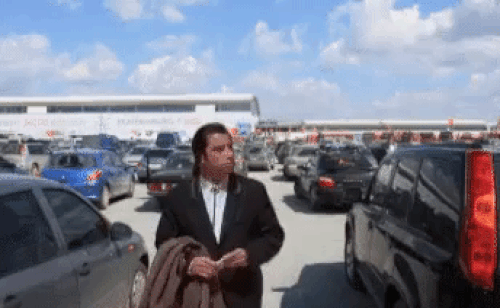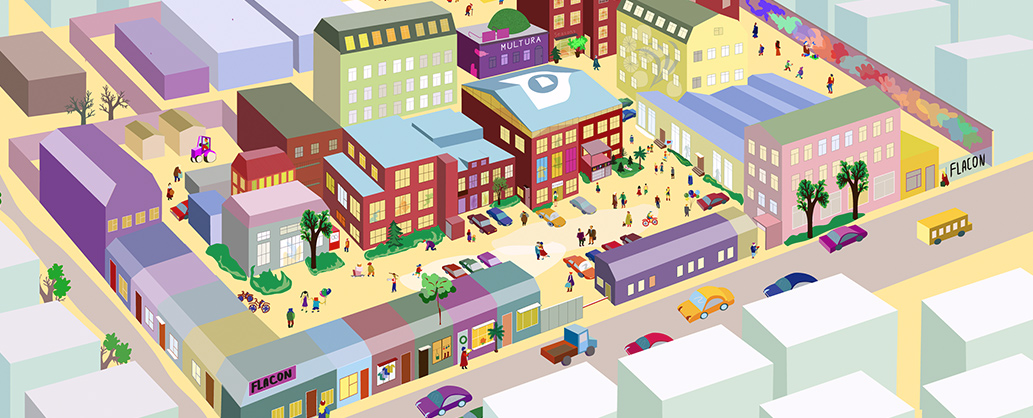My address is not a house or a street: what will be the address of the XXI century

Vincent Vega in the parking lot. Vincent Vega in the clinic. Vincent Vega in the city of Kovrov, Vladimir Region ... Memes with the bewildered hero of John Travolta are not only funny, but also true. Who among us did not find ourselves in a situation of hopeless search for an object, when all that remains is to be shaken up?
The two most common approaches to addressing - postal and geo-coordinate - are often powerless in the modern world. Due to an incorrectly specified address, 20% of mail correspondence is returned to senders. The inability to clearly explain their exact location reduces the client flow of businesses that are not lucky with the address. People spend their lives and nerves before they find what they’re looking for.
For example, the location of the well-known design factory Flacon can be described by the postal address: Bolshaya Novodmitrovskaya ul., 36s1, Moscow, Russia, 127015 . In some cases it may be appropriate to look for the “Flacon” by geographic coordinates: its latitude is 55.8048662 , longitude is 37.5852907 . Despite the presence of these two ways of addressing, representatives of companies located on the "Flacon" spend a lot of time to explain to visitors how to find the right office.

And here, in the address of traditional addressing systems, I often want to say: “ This is a fiasco, bro .”
The thing is, they are:
• Difficult to normalize.. The international address consists of 6 hierarchical levels, ordinary people easily confuse them in dozens of ways. The abbreviation system used makes understanding the address even more difficult: decipher, for example, the meaning of the abbreviation “p / st” *
* p / st - this is the “settlement at the station”.
As a result, there is a loss of correspondence or goods ordered on the Internet. Fortunately, there are several convenient services that have learned to bring addresses into the divine form.
• Not universal. In different countries, addresses are built according to different standards. For example, in Alaska there is a house with the address “City of Whittier”. Almost all city residents live in the 14-storey former army barracks built in 1956. At the same address are the police station, medical clinic, church and laundry. And how do you tell them to distinguish each other's addresses?
• Depend on language . The standard requirement to write an address in the language of the country and in English creates the risk of incorrect translation and transliteration. How correctly the sender of your Amazon-order should write in the address: Bus Station or Avtostantsya? Street or Ulitsa? The problem is aggravated by the fact that there are types of writing in the world (hieroglyphs) that are generally not understandable to speakers of other languages.
• geographic oriented. The address indicates a place in the village or on the map, but not a specific person. The address cannot be moved to the next street or taken with you when moving.
• Suffer from duplicates . There is its own Olympic Avenue both in Moscow and in Mytishchi. In St. Petersburg - two Novoaleksandrovsky streets. And Finnish and Finnish lane are confused even by native St. Petersburg people.
• Suffer from confusion in the “lower” steps of the address hierarchy. This may include a problem with the numbering of houses, buildings, buildings, properties, pavilions, entrances, etc. The address is often given to a group of buildings: for example, a plant with dozens of buildings may have a single address.
Does this mean that traditional addressing systems are no longer compatible with life? We believe that it is. Modern humanity - and we are in the forefront - is on the verge of creating an “address of the 21st century”.
The first practical step towards simplifying and “modernizing” addressing could be the decentralization of rights to assign postal addresses.
Now the assignment, modification and cancellation of addresses is in the hands of local governments. In addition, each region and municipality set its own rules and administrative regulations governing addressing issues. Of course, they all take into account the provisions of federal legislation, but there is no unified picture. Even within the same region, information required for address generation is provided by different departments - BTI, departments of architecture, housing management, etc. Their information systems are not synchronized well, the same property in different IP has a different set of characteristics and codes. Add to this the instability of the base of postal addresses due to changes in the city limits, land surveying and merging sites, the mistakes of the cadastral chamber workers - and you will understand
As for geo-information services and cartographic platforms such as Google Maps and Yandex.Maps, they do not take into account all the life scenarios in which people and businesses want to accurately determine their location.
For example, the question remains of the “last mile” - a detailed description of the actions, the direction of turns, the number of steps and steps that a person must overcome in order to find the desired object. Equally, the issues of address relocation, address coding of time-limited events, etc. are not resolved.
Vulnerabilities of “traditional” addressing systems lead to the idea of “address opposite”: in the future, the user should assign the address and not satellites. Of course, this will require:
a) the creation of a unified and verified address platform recognized by all subjects of addressing;
b) the ability to use the address as a container for any information that is important to the user: mailing address, geo-coordinates, “last mile” descriptions, work schedules and other useful data.
Thus, in the debate on the ideal “address of the 21st century”, the requirements for an optimal addressing system have already matured:
• The address must contain structured dataand provide accurate localization of objects inside buildings. The completeness of this address must be exhaustive: the ideal address contains the operating mode of the company, offers alternative addresses depending on the time of day, gives different routes for pedestrians and motorists, etc. In fact, the address becomes a mini-site with additional useful information.
• The address must be numeric . The sequence of numbers is the most convenient identification for all users, regardless of language. Such an address is convenient to convey to the interlocutor, it is equally clear to people and computers. The sequence of numbers should be easily recognizable visually and by ear, be simple to pronounce the voice.
• The address must be assigned by the user.and not by state or satellite. The presence of the owner will allow you to buy and sell the address, rent it out and carry out other operations related to the possession of the address.
• User friendly address . It should be easy for the user to create and transmit an address, move with the old address to a new location, etc.
• Secure data storage . The address must be unique and burglar-proof. All change history should be available.
We are working in Naviaddress on the solution of these five tasks, developing a modern platform for addressing places and objects. Our smart digital address, or simply Naviadres, combines the most current addressing methods - postal address, geo-coordinates and PlusCodes. As well as useful information - a textual and photographic description of the “last mile” route and any additional information about the object. The universal digital address format eliminates the language barrier in cross-cultural communication and cross-border transactions, it is clearly understood by people and computers. For e-commerce and delivery businesses, naviadres solves the problem of the last mile, including the normalization, verification and geolocation of the delivery address.
Naviaddress introduces a new standard for addressing. Navi card is easy to create and send in one click. The address system can be used without a special application. You simply follow the link with the navi address, for example, naviaddress.com/7495/942198 and get detailed information: address, route, hours of operation, links to social networks, etc.
To ensure data security, Naviaddress uses blockchain technology. The creation of ownership of the naviadresom is implemented through smart contracts. Naviadres can be bought, sold or rented.
All these decisions allowed us to streamline the multilingual informational chaos in the field of addressing places and objects. And create a system for storing and using smart digital address platform - unified, simple and understandable for humans and computers. Vincent Vega would be pleased with us.
On the real cases of using Naviaddress in modern user situations, industries and industries, we will tell in the following posts.
Vladimir Yastrezembsky, Danila Yusma and Andrey Gershun contributed to the article.
